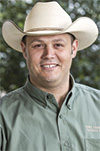Typically, producers provide additional feed during cold weather, which means a higher feed bill.
For cattle with a dry winter hair coat, their lower critical temperature (LCT) is 32ºF. Temperatures or wind chill below this LCT will increase their energy requirements.
If the same cattle have a wet winter hair coat, energy requirements start increasing for wind chill values less than 60ºF. It is easy to see that protecting cattle from winter wind can quickly add up in feed savings.
Evaluate existing shelter
Many pastures have some kind of natural wind protection with varying degrees of effectiveness. It is obvious that trees and draws provide protection, but cattle will also shelter behind brush piles, below pond dams and terraces, and in low places.
However, some natural windbreaks are not ideal, especially if cattle would be lying in mud. Mud can increase their energy requirements as much as 30 percent.
Taking advantage of a good natural windbreak might be as easy as moving cattle from one pasture to another during winter. However, if natural options are limited, consider a man-made windbreak.
Before building anything, decide if you have adequate shelter. It is generally recommended that calves up to 600 pounds need at least 15 square feet of protected ground surface per head.
Larger calves and cows will need 20 square feet or more. Take time to watch your stock on a windy day. They will usually tell you where the protection is by where they choose to bed down.
Walk through these areas, making note of the wind direction and the size of the sheltered area.
Portable or permanent
If you identify the need for additional windbreaks, think about how often you will move animals and how many different pastures are used during harsh weather.
Many cow-calf producers winter their herd in one or two pastures to make checking and feeding easier. Having a permanent windbreak in these areas might be the cheapest option.
However, for those who plan to move cattle often or when grazing wheat pastures, a portable structure might be best.
These typically cost more but provide flexibility when planting and with rotational grazing. Moving the location of a windbreak often allows for more uniform distribution of manure and helps prevent damage to forage plants.
Location
Windbreaks should always be placed in a well-drained area to keep animals out of the mud and allow for drainage of any melted snow accumulation.
Location is going to be site-specific, but consider how the surrounding terrain will affect the downwind effectiveness. Buildings and tree lines can act as a funnel and increase wind speed.
Additionally, avoid placing windbreaks close to riparian areas and immediately uphill from ponds to prevent manure contamination from runoff.
If located in line with a fence, orient the windbreak east to west to prevent access to the north side. If located away from a fence, consider orienting half of the windbreak to block a north wind and the other half to block a northwest wind (the predominant prevailing winds in the Southern Plains during harsh winter weather).
Use caution when placing permanent windbreaks in small pens. These can be detrimental to air flow in the summer, which could compound the effects of heat stress.
Design considerations
Research has shown that perforated windbreaks provide a greater area of protection downwind. This might sound counterintuitive, but allowing a small amount of air to pass through the windbreak helps prevent the downdraft that occurs with a solid windbreak. Ideally, windbreaks should be 20 to 33 percent porous.
For example, a windbreak that uses 6-inch-wide boards spaced 2 inches apart is 25 percent porous. This perforated design should provide an area of wind protection that is 10 times the height of the windbreak.
Therefore, a windbreak that is 8 feet tall and 10 feet long should provide a protected area that is 800 square feet, adequate shelter for about 40 cows or 50 stockers.
The materials used to construct a windbreak can vary widely. Consider the cost, safety and life-span of your options.
Treated lumber is safe and cost-effective due to its expected life-span, but cheaper options are available.
With portable structures, it is generally recommended that the base be at least one-and-a-half times as wide as the height, which will increase the cost. Be aware that skids may freeze in place due to the amount of ground contact.
Every operation is different, and each pasture will have a unique need for windbreaks. The decision to construct a windbreak should be based on animal welfare and economics.
However, a relatively small structure will protect several animals and, if well-built, should last many years. ![]()

Deke Alkire
Livestock Consultant
Noble Foundation






